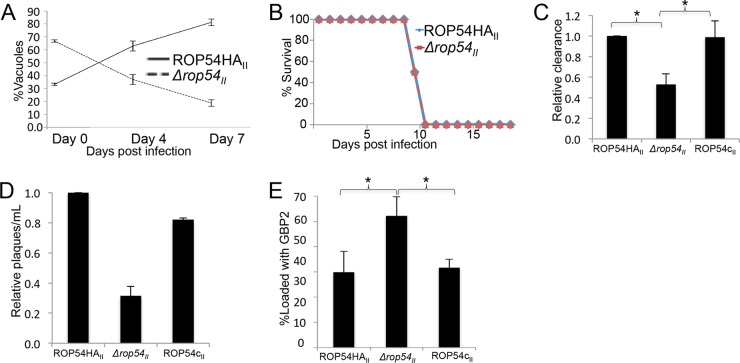FIG 6 .
ROP54 modulates IFN-γ-dependent parasite clearance through the interference of GBP2 loading on the PV. (A) In vivo competition assay results for ROP54HAII and Δrop54II parasite lines, showing a steady increase in the percentage of ROP54HAII vacuoles and a steady decrease in the percentage of Δrop54II vacuoles as the coinfection progressed (n = 6, from two independent experiments). (B) IFN-γR−/− mice were injected with 5,000 parasites of ROP54HAII or ∆rop54II and became moribund with the same kinetics, suggesting that ROP54 modulates an IFN-γ-dependent response (n = 4). (C) RAW 267.4 cells were activated with IFN-γ and LPS for 24 h. The parasite strains ROP54HAII, ∆rop54II, and ROP54cII were used to infect the cells for 20 h at an MOI of 1. qPCR demonstrated an ~50% decrease of ∆rop54II parasites relative to levels with the parental and complemented strains. Significance was determined by a one-way ANOVA. *, P < 0.05 (n = 3). (D) Primary BMDMs were activated with IFN-γ and LPS for 24 h. The strains ROP54HAII, ∆rop54II, and ROP54cII were used to infect the cells for 20 h at an MOI of 1. Parasites were liberated by manual disruption and quantitated in a plaque assay. Values were normalized to ROP54HAII, and a decrease in ∆rop54II viability was demonstrated (n = 2). (E) MEFs were primed with IFN-γ and LPS. The ROP54HAII, ∆rop54II, and ROP54cII parasite lines were used to infect the cells for 12 h. The proportion of GBP2 loading on the vacuoles of ∆rop54II-infected cells was significantly increased, based on a one-way ANOVA. *, P < 0.05 (n = 3). The decrease in loading was restored to wild-type levels upon complementation.

